Influence of Atmospheric Non-Uniform Saturation on Extreme Hourly Precipitation Cloud Microphysical Processes in a Heavy Rainfall Case in Zhengzhou
Abstract
:1. Introduction
2. Case Overview and Synoptic Conditions
2.1. Case Overview
2.2. Analysis of Synoptic Conditions
2.2.1. Circulation Configuration
2.2.2. Skew T/Log p Analysis
2.2.3. Analysis of Water Vapor and Heat Conditions
3. Non-Uniform Saturation and Comparative Experiment Design
3.1. Introduction of Non-Uniform Saturation and Generalized Potential Temperature
3.2. Application of Non-Uniform Saturation to Cloud Microphysical Schemes
3.3. Model Experiment Design
4. Model Verification
4.1. Verification by Automatic Weather Station
4.2. Verification by Doppler Weather Radar
5. Mesoscale Environment and Cloud Microphysical Features of Extreme Rainfall Intensity
5.1. Mesoscale Environment of Extreme Rainfall Intensity
5.2. Cloud Microphysical Features of Extreme Rainfall Intensity
6. Possible Mechanisms by Which Cloud Microphysical Processes Affected the Extreme Hourly Precipitation
6.1. Mass and Heat Balance of Water Condensates in the MCS
6.1.1. Mass Balance of Rainwater Particles
6.1.2. Latent Heat Balance of Water Condensates
6.2. Possible Cloud Microphysical Mechanism during Extreme Hourly Precipitation
7. Conclusions
- The supersaturation and water vapor condensation caused by the intrusion of dry and cold air from the upper and middle levels is the main reason for the heavy rainfall in Zhengzhou. This environment of high temperature gradients and humidity gradients is more suitable for the application of generalized potential temperature. The new cloud microphysical scheme that takes into consideration that the non-uniform saturation theory was effective in improving the simulation capability of extreme hourly cumulative rainfall intensity and 24 h cumulative rainfall zone for heavy rainfall over Zhengzhou.
- Extreme hourly cumulative precipitation over Zhengzhou occurred with strong upward motion, which brought supercooled water and water vapor from the lower levels to the upper levels, forming ice-phase particles through the Bergeron process and the freezing process. Ice-phase particle sublimation and deposition processes produced positive feedback to the mesoscale environment, such as the Prd, Prds, Prdg, Eprd, and Eprdg processes. A mesoscale environment that is more conducive to convective generation will in turn enhance upward motion and ice-phase particle mixing ratios. The ice-phase particles fall into the melting layer and melt into raindrops, such as the Psmlt and Pgmlt processes.
- Comparing the new scheme with the original scheme, there are two obvious differences in the cloud microphysical processes. One is that the Psmlt process is much larger in new scheme. The other is that the peak of the Prds process is higher in the new scheme. The main reason for this phenomenon is that water vapor is more likely to saturate and condensate when considering the non-uniformity of saturation in the atmosphere in the new scheme. This resulted in more supercooled water droplets, more snow melting, and stronger motion. These phenomena interact with positive feedback to contribute to stronger rainfall intensity in the new scheme.
Author Contributions
Funding
Institutional Review Board Statement
Informed Consent Statement
Data Availability Statement
Conflicts of Interest
Appendix A
| Cloud Microphysical Process Abbreviation | Description |
|---|---|
| Eprds | Sublimation of snow |
| Eprdg | Sublimation of snow graupel |
| Eprd | Sublimation of cloud ice |
| Prds | Deposition of snow |
| Prdg | Deposition of graupel |
| Prd | Deposition of cloud ice |
| Evpmg | Melting and evaporation of graupel |
| Evpms | Melting and evaporation of snow |
| Pre | Evaporates of rain |
| Pgracs | Conversion to graupel due to collection rain by snow |
| Mnuccr | Contact freezing of rain |
| Pracg | Rain-graupel collection |
| Pracs | Rain-snow collection |
| Praci | Change QI, ice-rain collection |
| Piacrs | Change QR, ice-rain collision, added to snow |
| Pracis | Change QI, ice-rain collision, added to snow |
| Psacr | Conversion due to collection of snow by rain |
| Prai | Conversion due to collection of snow by cloud ice |
| Prci | Ice-ice collision, added to snow |
| Psacwg | Change Q droplets collection by graupel |
| Psacws | Change Q droplets accretion by snow |
| Psacwi | Change Q droplets accretion by cloud ice |
| Pgmlt | Melting of graupel |
| Psmlt | Melting of snow |
| Pcc | Condensation/evaporation of cloud droplets |
| Pra | Accretion droplets by rain |
| Prc | Auto-conversion of droplets |
References
- Zhang, H.; Hou, J.Z.; Qiao, J. A comprehensive analysis of some characteristics of heavy rainfall in Shaanxi. Disaster Sci. 2011, 26, 70–74. [Google Scholar]
- Guo, Y.; Shao, C.; Su, A. Investigation of land–atmosphere coupling during the extreme rainstorm of 20 July 2021 over Central East China. Atmosphere 2023, 14, 1474. [Google Scholar] [CrossRef]
- Xu, J.; Ping, F.; Li, J.Y.; Du, H. A study of cloud microphysical processes and a mesoscale environment in a heavy rainfall case over Yan’an. Front. Earth Sci. 2023, 11, 1149856. [Google Scholar] [CrossRef]
- Shi, W.; Li, X.; Zeng, M.; Yang, H.; Ma, S.; Zhou, K.; Shen, D.; Jiao, B.; Li, N. Multi-model comparison and analysis of high-resolution regional model forecasts for the “7–20” heavy rainstorm in Zhengzhou. J. Atmos. Sci. 2021, 44, 88702. [Google Scholar]
- Chen, Y.; Ping, F.; Zhou, S.; Shen, X.; Sun, Y. Influence of microphysical processes on the initiation of the mesoscale convective system of a rainstorm over Beijing. Atmos. Res. 2021, 254, 105518. [Google Scholar] [CrossRef]
- Thoithi, W.; Blamey, R.C.; Reason, C.J.C. April 2022 floods over East Coast South Africa: Interactions between a mesoscale convective system and a coastal Meso-Low. Atmosphere 2023, 14, 78. [Google Scholar] [CrossRef]
- Randall, D.A.; Bitz, C.M.; Danabasoglu, G.; Denning, A.S.; Gent, P.R.; Gettelman, A.; Griffies, S.M.; Lynch, P.; Morrison, H.; Pincus, R.; et al. 100 years of earth system model development. Meteorol. Monogr. 2019, 59, 12.1–12.66. [Google Scholar] [CrossRef]
- Schwartz, C.S.; Romine, G.S.; Fossell, K.R.; Sobash, R.A.; Weisman, M.L. Toward 1-km ensemble forecasts over large domains. Mon. Weather. Rev. 2017, 145, 2943–2969. [Google Scholar] [CrossRef]
- Zhang, B.; Zheng, Y.Y.; Shen, F.F.; Zeng, Y.; Wang, Y. Characteristics and simulation of a torrential rainstorm over southern Jiangsu in 2017 revealed by a high-resolution numerical model. J. Meteorol. Sci. 2021, 41, 386–397. [Google Scholar]
- Li, H.Q.; Zhang, D.L. Recent advances and future challenges in high-resolution numerical simulation of mesoscale convective systems. Adv. Meteorol. Sci. Technol. 2021, 11, 75–91. [Google Scholar]
- Van, W.K.; Van, L.N.P.M.; Delobbe, L. Evaluation of moist processes during intense precipitation in km-scale NWP models using remote sensing and in-situ data: Impact of microphysics size distribution assumptions. Atmos. Res. 2011, 99, 15–38. [Google Scholar]
- Houghton, J.T.; Ding, Y.; Griggs, D.J.; Noguer, M. Climate Change 2001: The Scientific Basis; Cambridge University Press: Cambridge, UK, 2001. [Google Scholar]
- Gao, S.T.; Cui, X.P.; Zhou, Y.S.; Li, X. Surface rainfall processes as simulated in a cloud-resolving model. J. Geophys. Res. 2005, 110, D10202. [Google Scholar] [CrossRef]
- Fan, J.W.; Zhang, R.Y.; Li, G.H.; Tao, W.K. Effects of aerosols and relative humidity on cumulus clouds. J. Geophys. Res. 2007, 112, D1420. [Google Scholar] [CrossRef]
- Mao, J.H.; Ping, F.; Yin, L.; Qiu, X. A study of cloud microphysical processes associated with torrential rainfall event over Beijing. J. Geophys. Res. Atmos. 2018, 123, 8768–8791. [Google Scholar] [CrossRef]
- Yin, L.; Ping, F.; Mao, J.H. Impact of cloud microphysical processes on the simulation of a hailstorm in East China. Atmos. Res. 2019, 219, 36–56. [Google Scholar] [CrossRef]
- Yang, S.; Gao, S.; Lu, C. A generalized frontogenesis function and its application. Adv. Atmos. Sci. 2014, 31, 1065–1078. [Google Scholar] [CrossRef]
- Gao, S.B. Research on the Application of Radar Data Assimilation in Strong Convective Weather Forecasting. Ph.D. Thesis, Nanjing University of Information Engineering, Nanjing, China, 2018. [Google Scholar]
- Sun, Y.; Xiao, H.; Yang, H.L.; Ding, J.; Fu, D.; Guo, X.; Feng, L. Analysis of dynamic conditions and water condensates transport characteristics of the 2021 Zhengzhou “7–20” heavy rainstorm based on remote sensing data optical flow field. Atmos. Sci. 2021, 45, 1384–1399. [Google Scholar]
- Yin, L.; Ping, F.; Mao, J.H.; Jin, S. Analysis on precipitation efficiency of the “21.7” Henan extremely heavy rainfall event. Adv. Atmos. Sci. 2023, 40, 374–392. [Google Scholar] [CrossRef]
- Zhou, Y.S.; Cao, J.; Wang, D.H. Application of non-uniform saturated generalized moist potential vorticity in heavy rainfall analysis and forecasting. J. Appl. Meteorol. Sci. 2007, 18, 754–759. [Google Scholar]
- Gao, S.; Wang, X.; Zhou, Y. Generation of generalized moist potential vorticity in a frictionless and moist adiabatic flow. Geophys. Res. Lett. 2004, 31, 12113. [Google Scholar] [CrossRef]
- Wang, X.R.; Wu, K.J.; Shi, C.E. Introduction of condensation probability functions and a set of non-uniform saturated wet air dynamics equations. J. Trop. Meteorol. 1999, 15, 64–70. [Google Scholar]
- Ping, F.; Tang, X.B.; Gao, S.T.; Luo, Z. A comparative study of the atmospheric circulations associated with rainy-season floods between the Yangtze and Huaihe River Basins. Sci. China Earth Sci. 2014, 57, 1464–1479. [Google Scholar] [CrossRef]
- Morrison, H.; Gettelman, A. A new two-moment bulk stratiform cloud microphysics scheme in the Community Atmosphere Model, Version 3 (CAM3). Part I: Description and numerical tests. J. Clim. 2008, 21, 3642–3659. [Google Scholar] [CrossRef]
- Zhou, K.L.; Ran, Q.Y.; Gao, Z. Characteristic analysis of general potential temperature and potential vorticity including freezing process. Atmos. Sci. 2020, 44, 816–834. [Google Scholar]
- Von, S.H.; Langenberg, H.; Feser, F. A spectral nudging technique for dynamical downscaling purposes. Mon. Weather. Rev. 2000, 128, 3664–3673. [Google Scholar]
- Glisan, J.M.; Gutowski, J.W.J.; Cassano, J.J.; Higgins, M.E. Effects of spectral nudging in WRF on Arctic temperature and precipitation simulations. J. Clim. 2013, 26, 3985–3999. [Google Scholar] [CrossRef]
- Huang, Y.J.; Cui, X.P. Dominant cloud microphysical processes of a torrential rainfall event in Sichuan, China. Adv. Atmos. Sci. 2015, 32, 389–400. [Google Scholar] [CrossRef]
- Heymsfield, A.; Wright, R. Graupel and hail terminal velocities: Does a “supercritical” Reynolds number apply. J. Atmos. Sci. 2014, 71, 3392–3403. [Google Scholar] [CrossRef]
- Hjelmfelt, M.R.; Roberts, R.D.; Orville, H.D.; Chen, J.-P. Observational and numerical study of a microburst line-producing storm. J. Atmos. Sci. 1989, 46, 2731–2744. [Google Scholar] [CrossRef]
- Guo, X.; Niino, H.; Kimura, R. Numerical modeling on a hazardous microburst-producing hailstorm. In Towards Digital Earth—Proceedings of the International Symposium on Digital Earth; Science Press: Beijing, China, 1999; pp. 383–398. [Google Scholar]
- He, G.X. Study on Velocity Decluttering of New Generation Doppler Weather Radar in China. Ph.D. Thesis, Nanjing University of Information Engineering, Nanjing, China, 2012. [Google Scholar]
- Sun, J.; Fu, S.; Wang, H.; Zhang, Y.; Zhang, Y.; Zhang, Y.; Zhang, Y.; Zhang, Y.; Ma, R. Primary characteristics of the extreme heavy rainfall event over Henan in July 2021. Atmos. Sci. Lett. 2022, 24, e1131. [Google Scholar] [CrossRef]
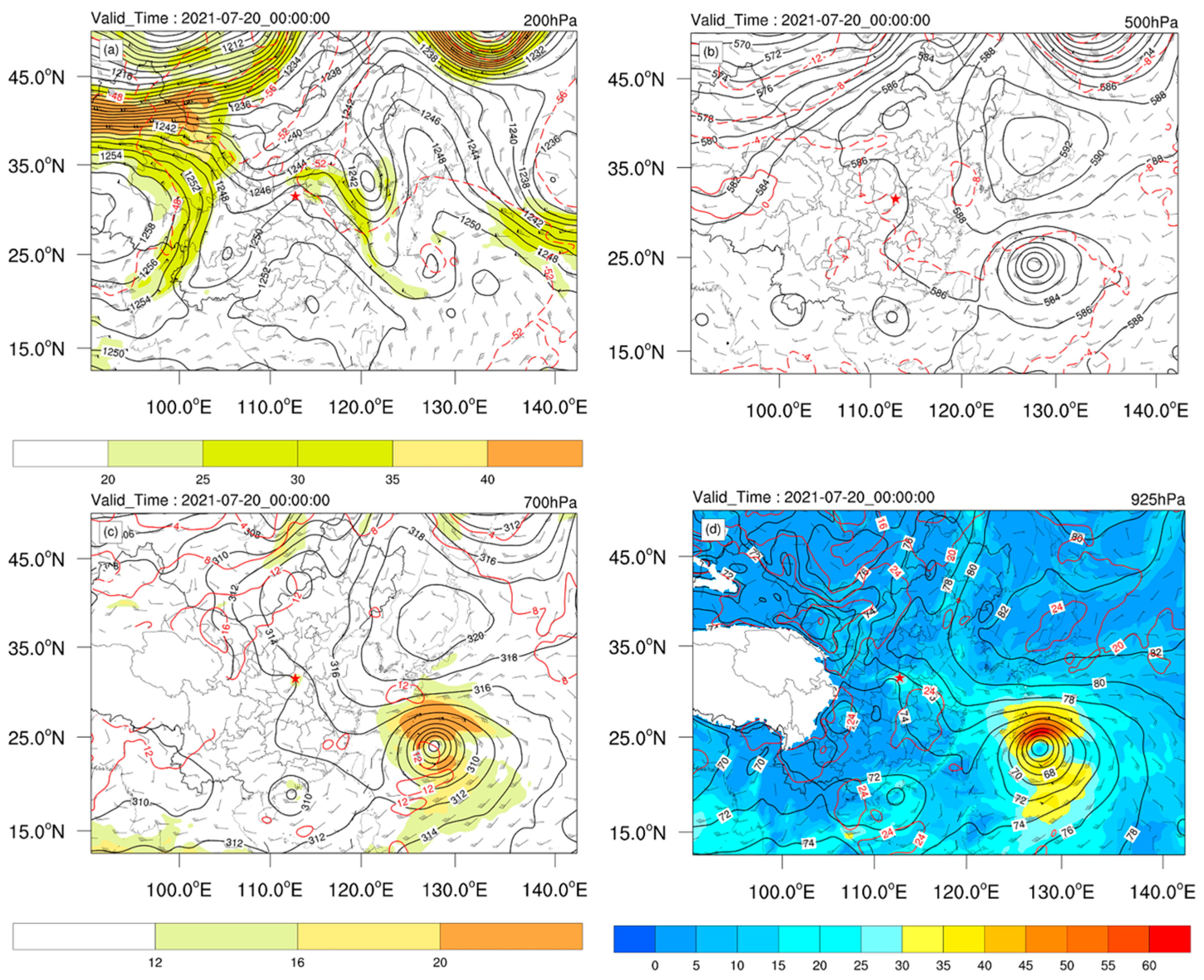
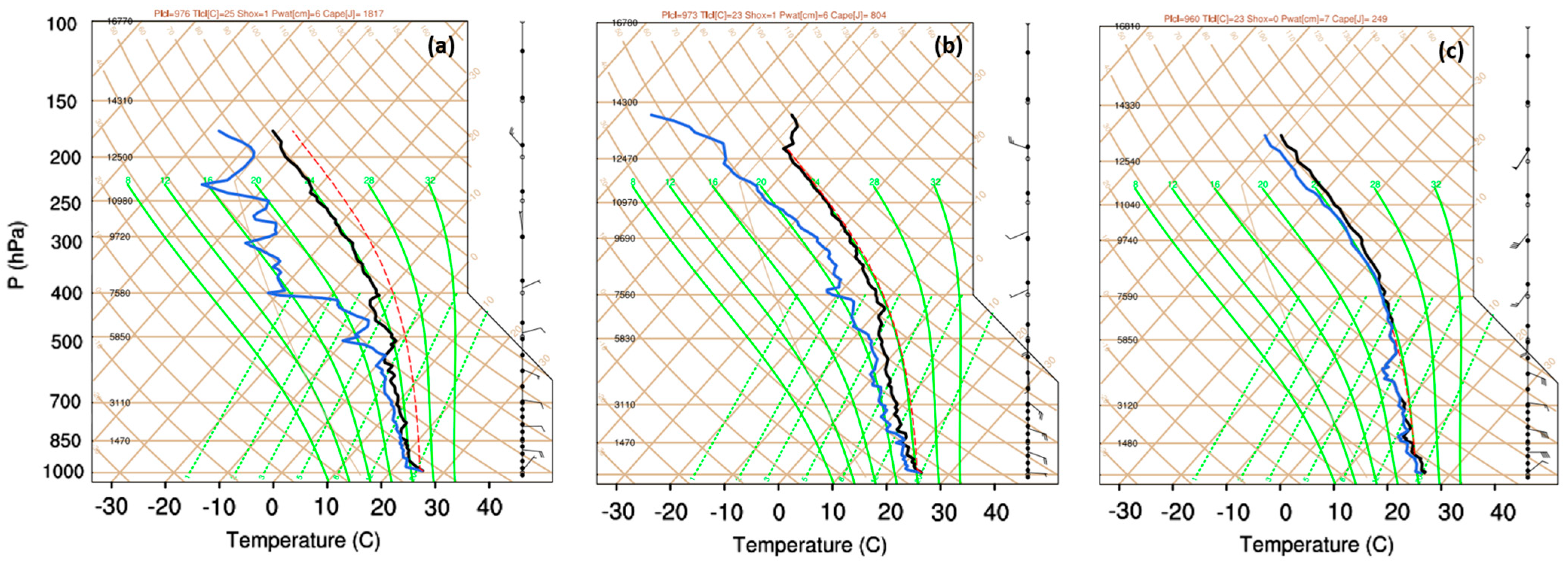
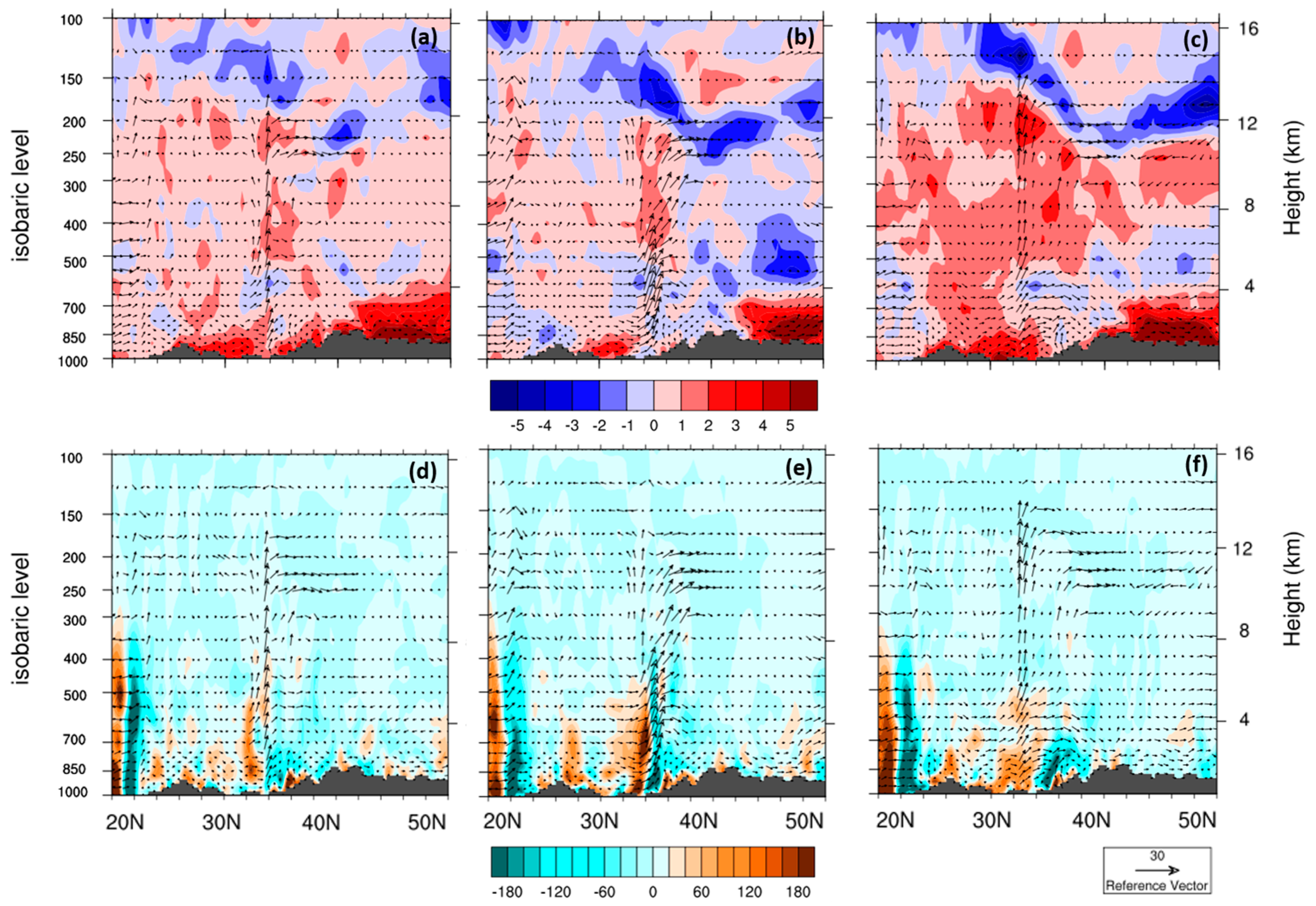
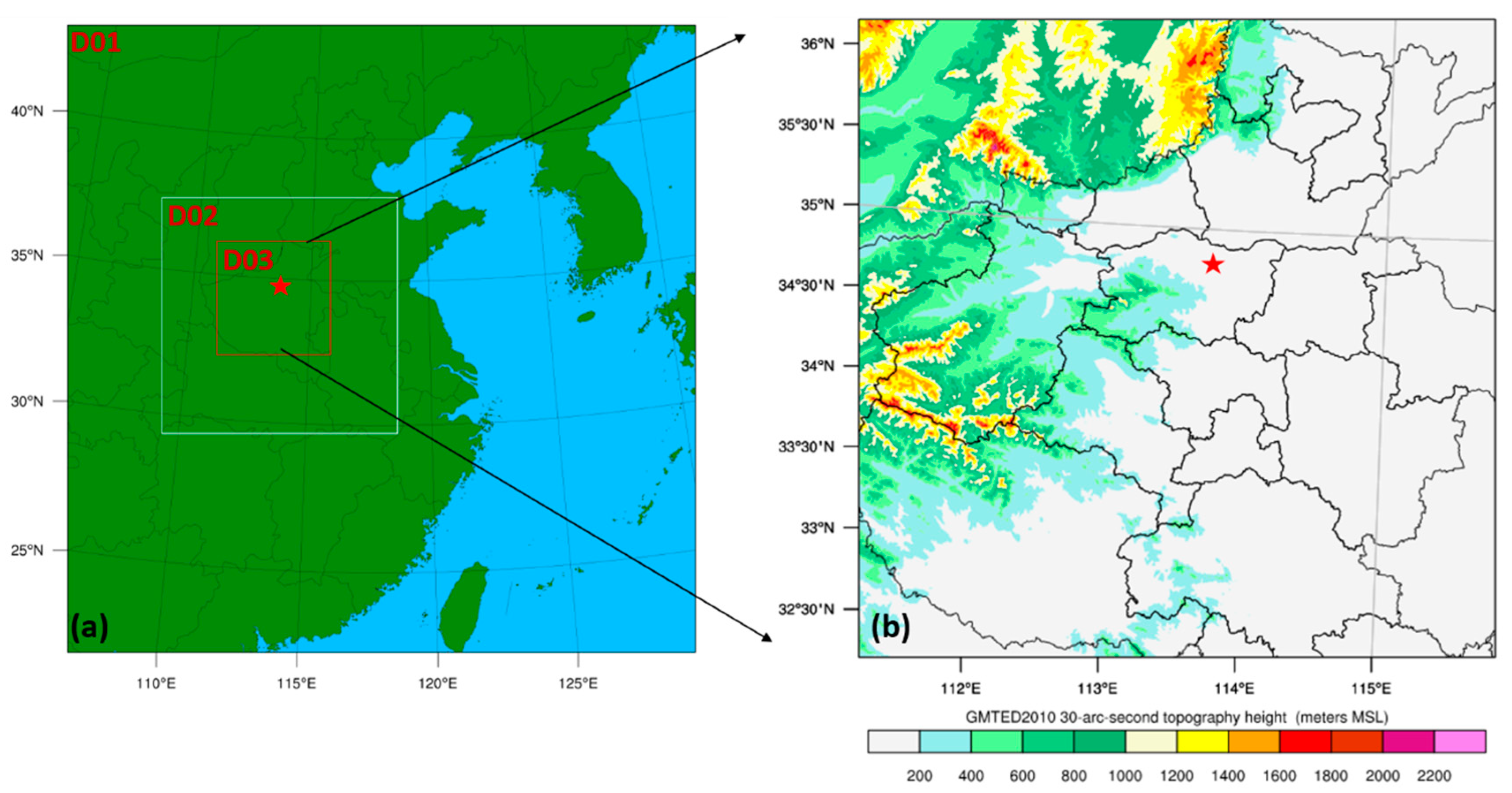
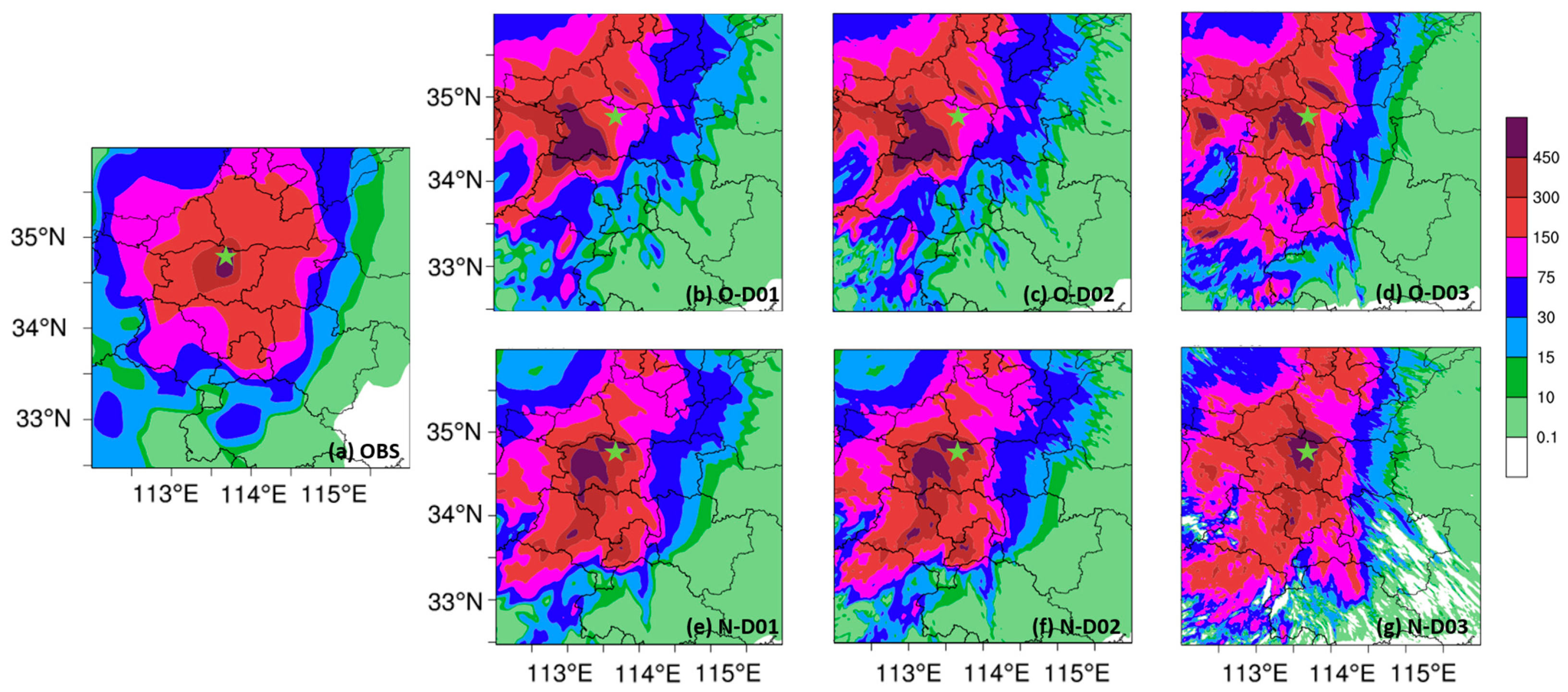
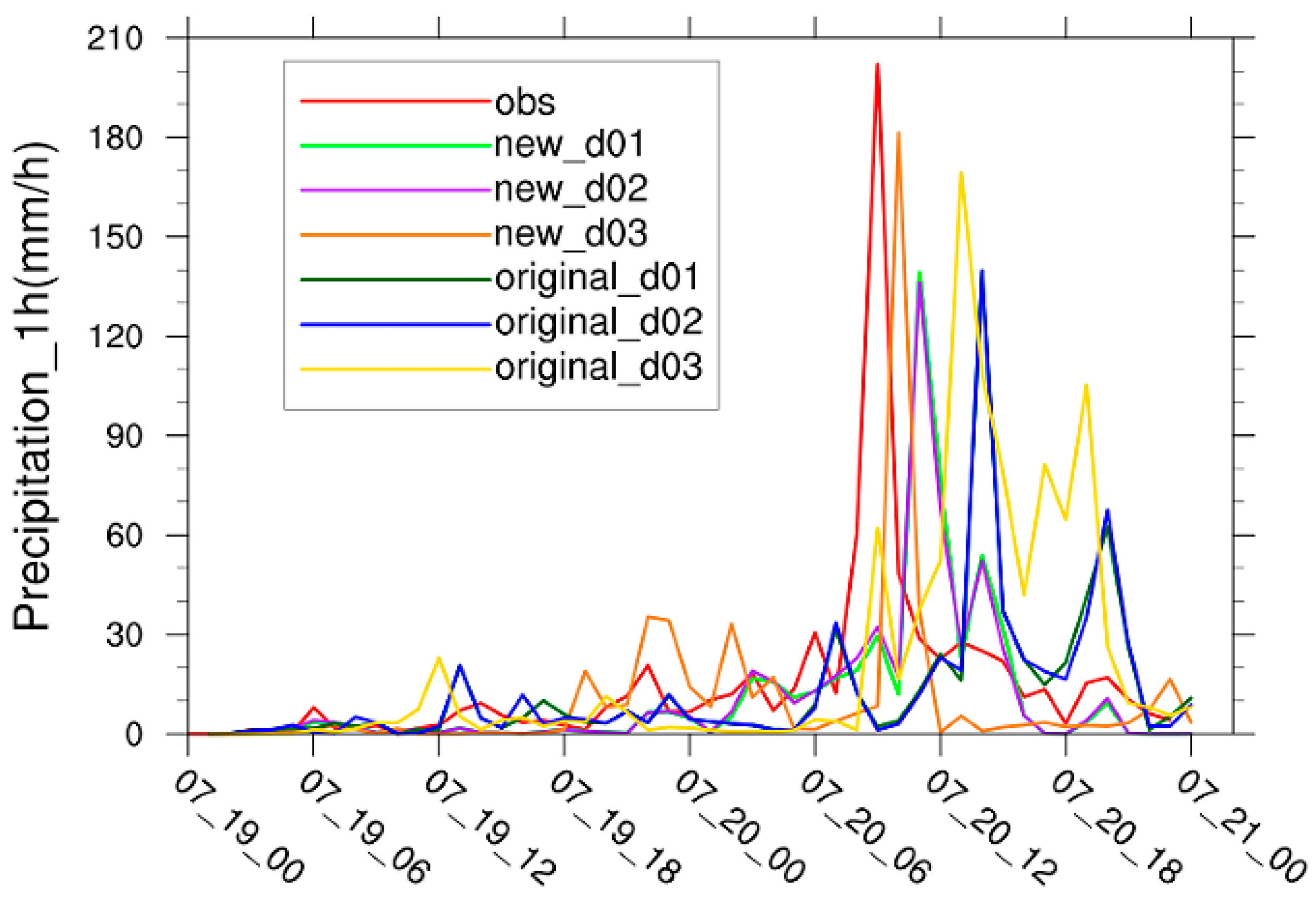

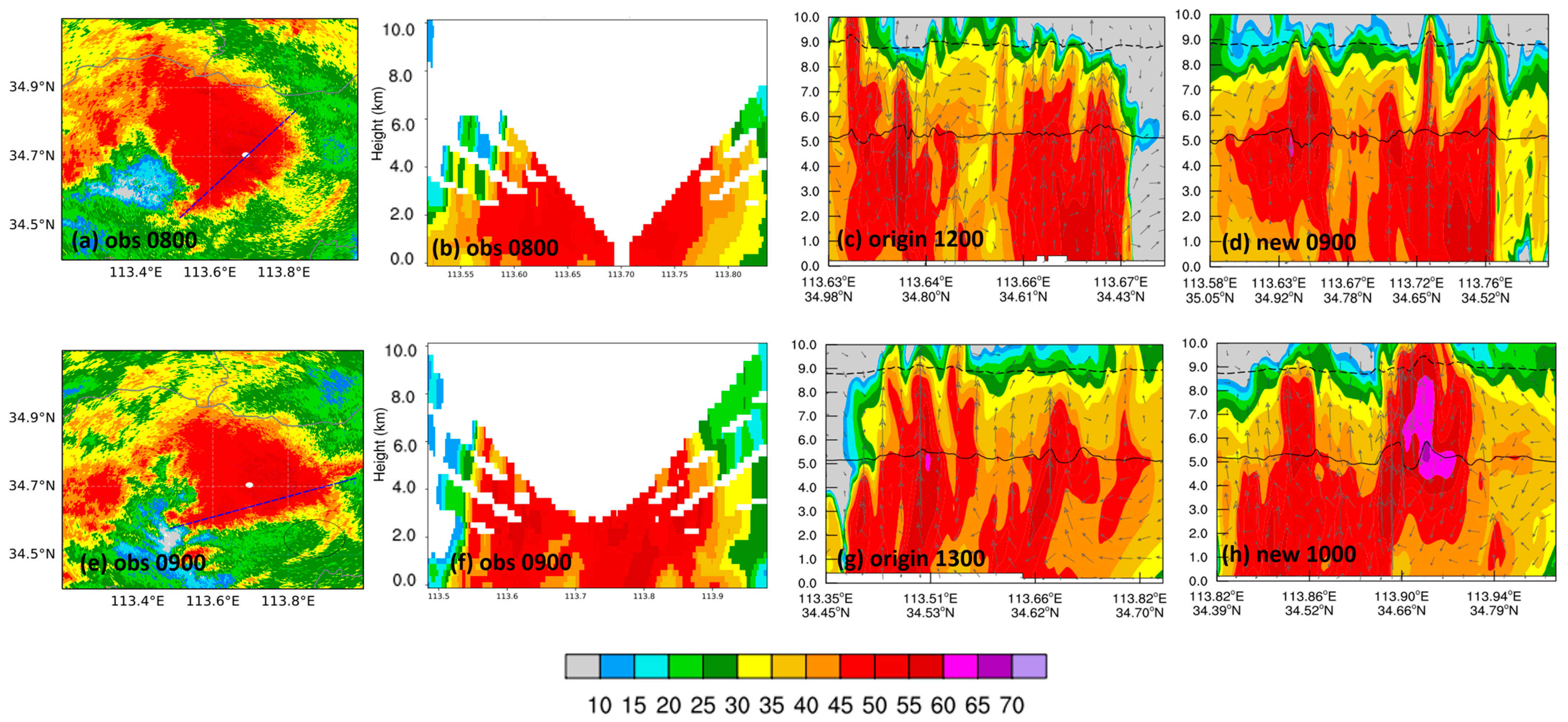
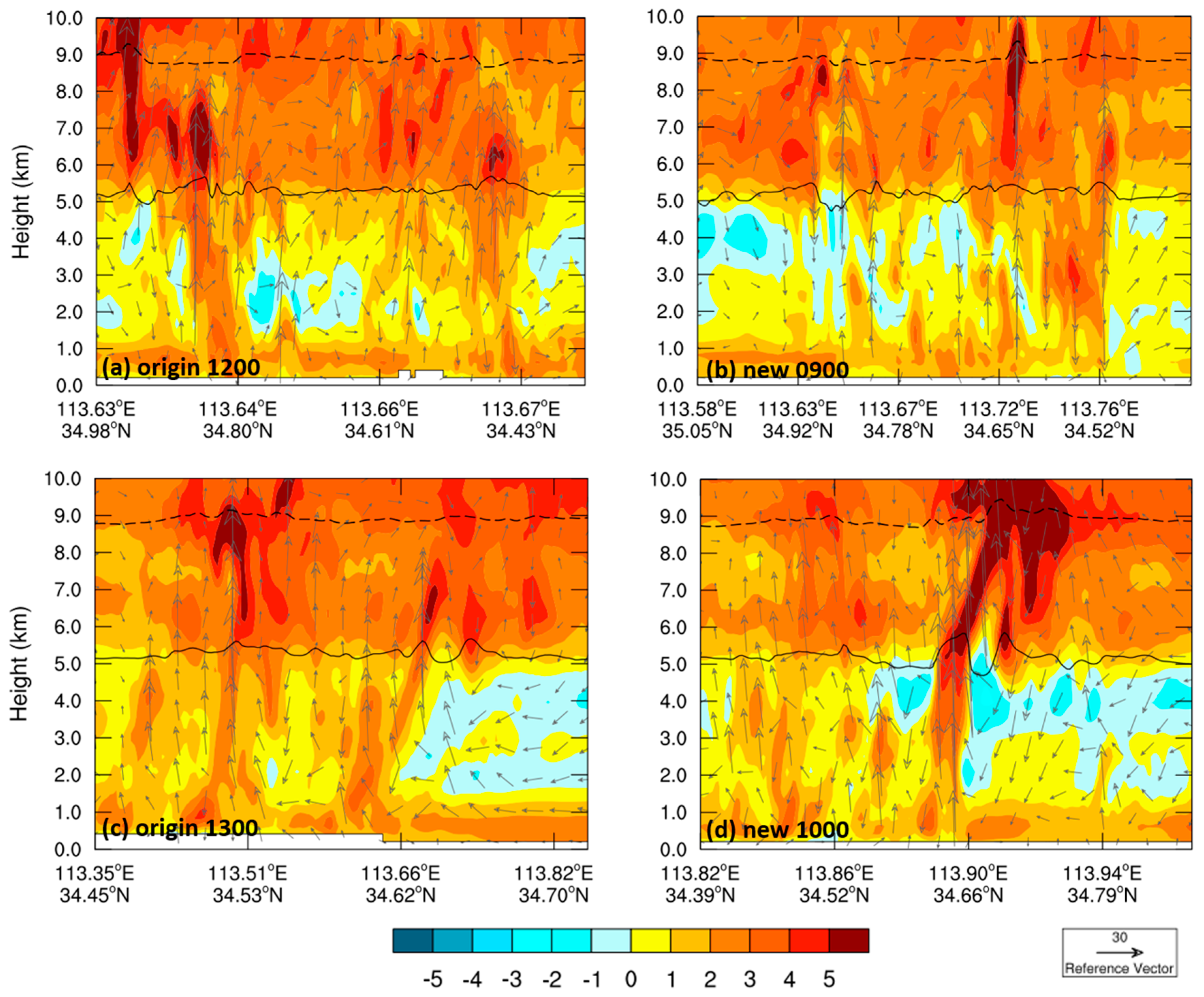
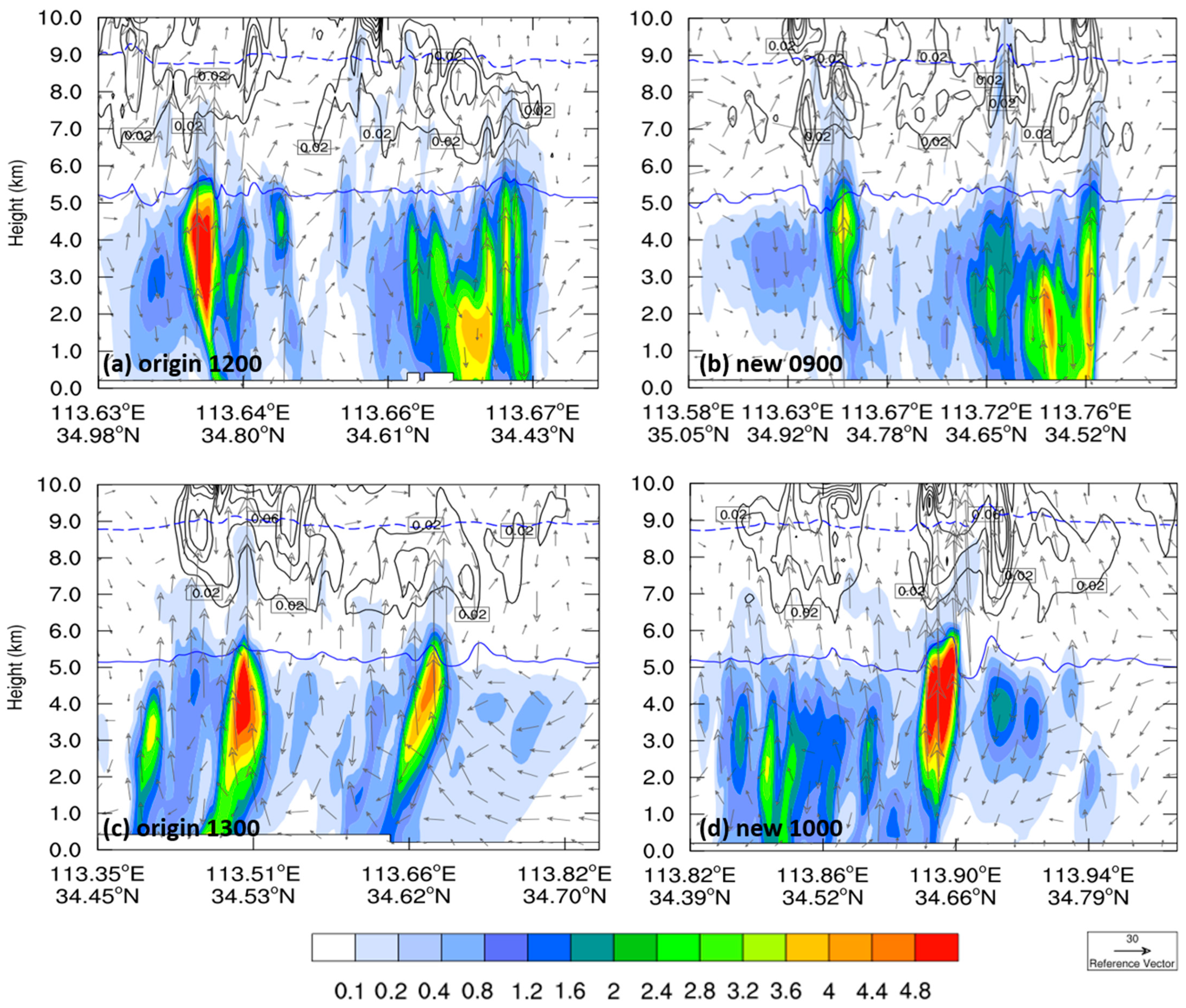
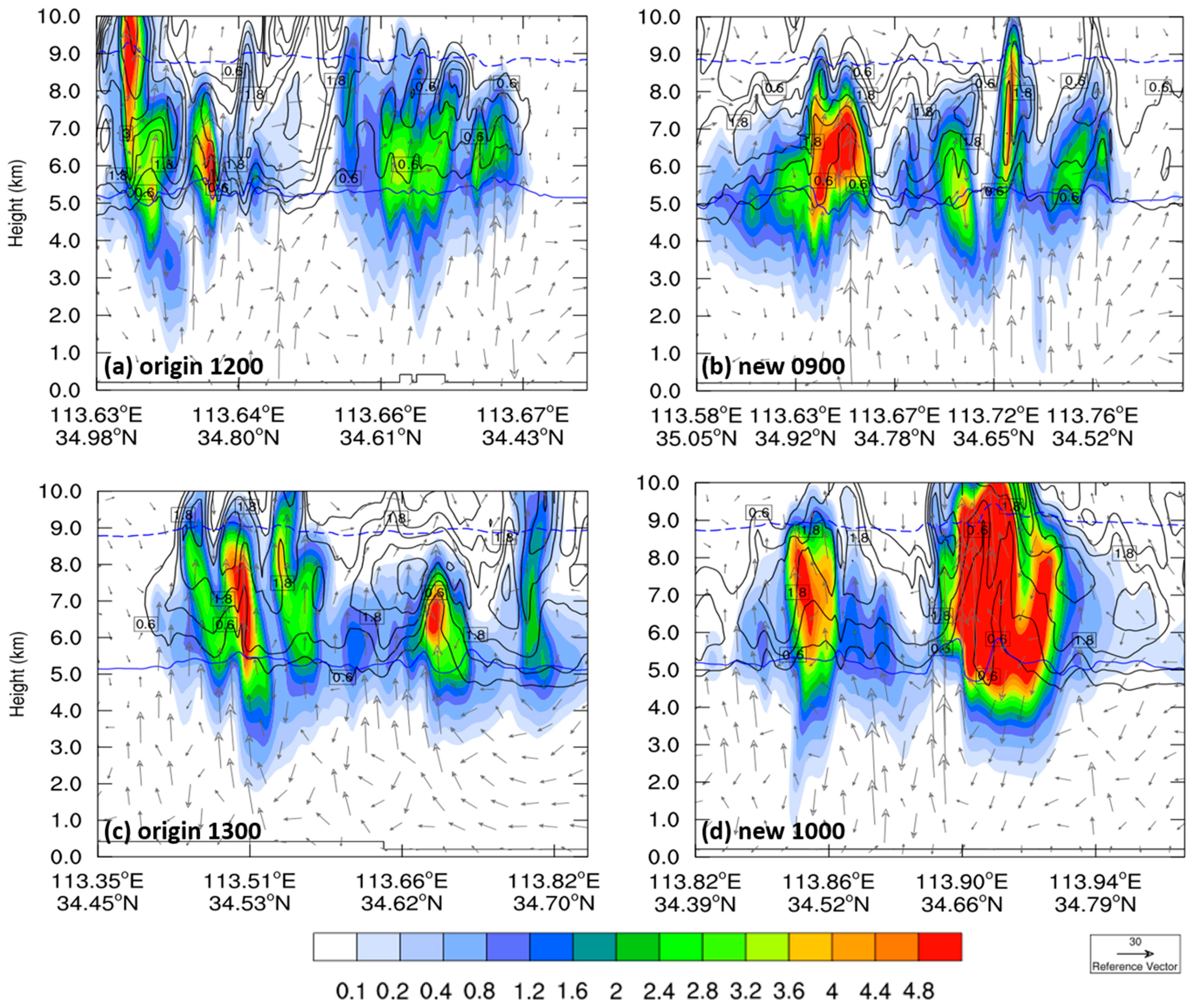
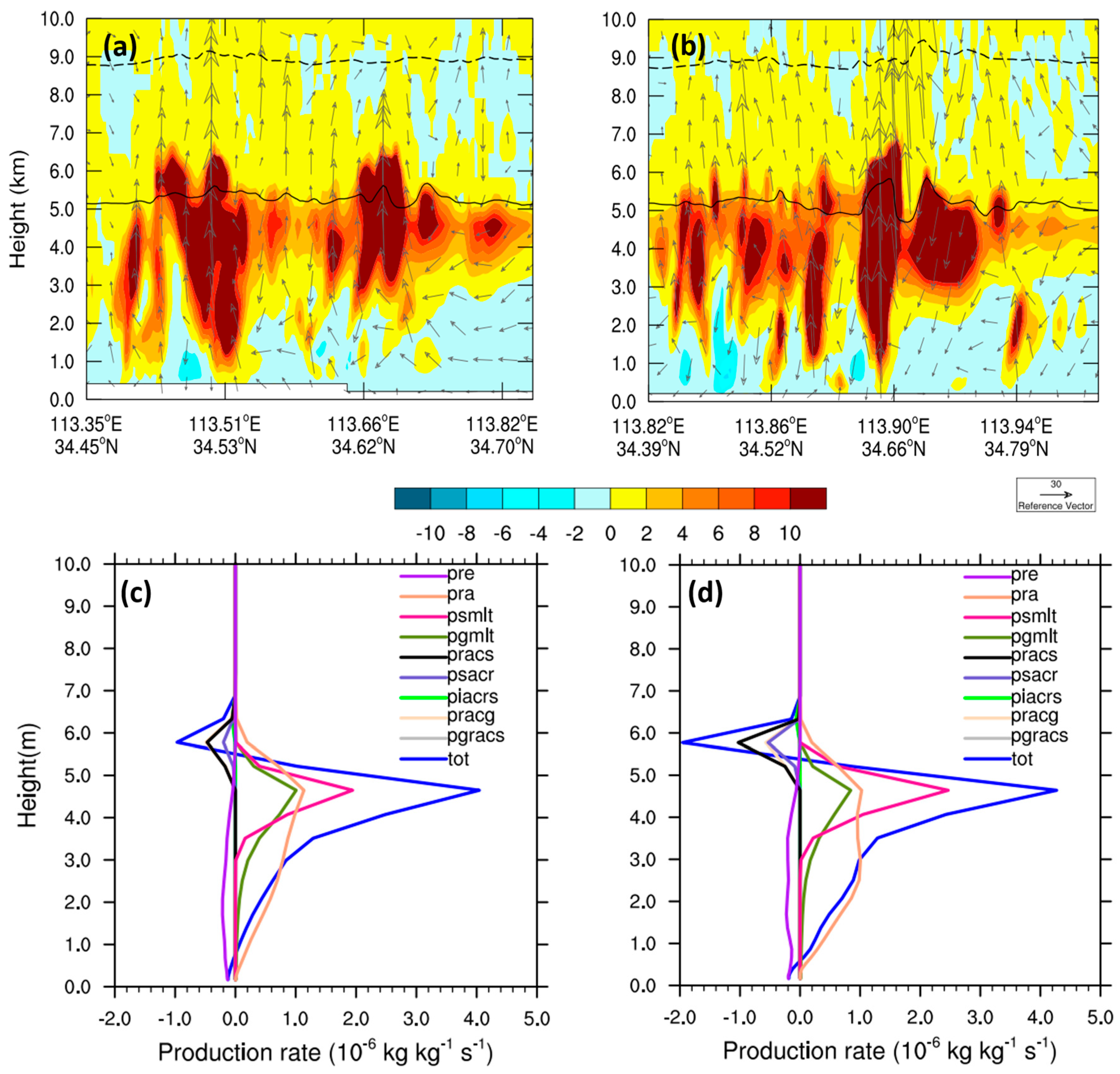

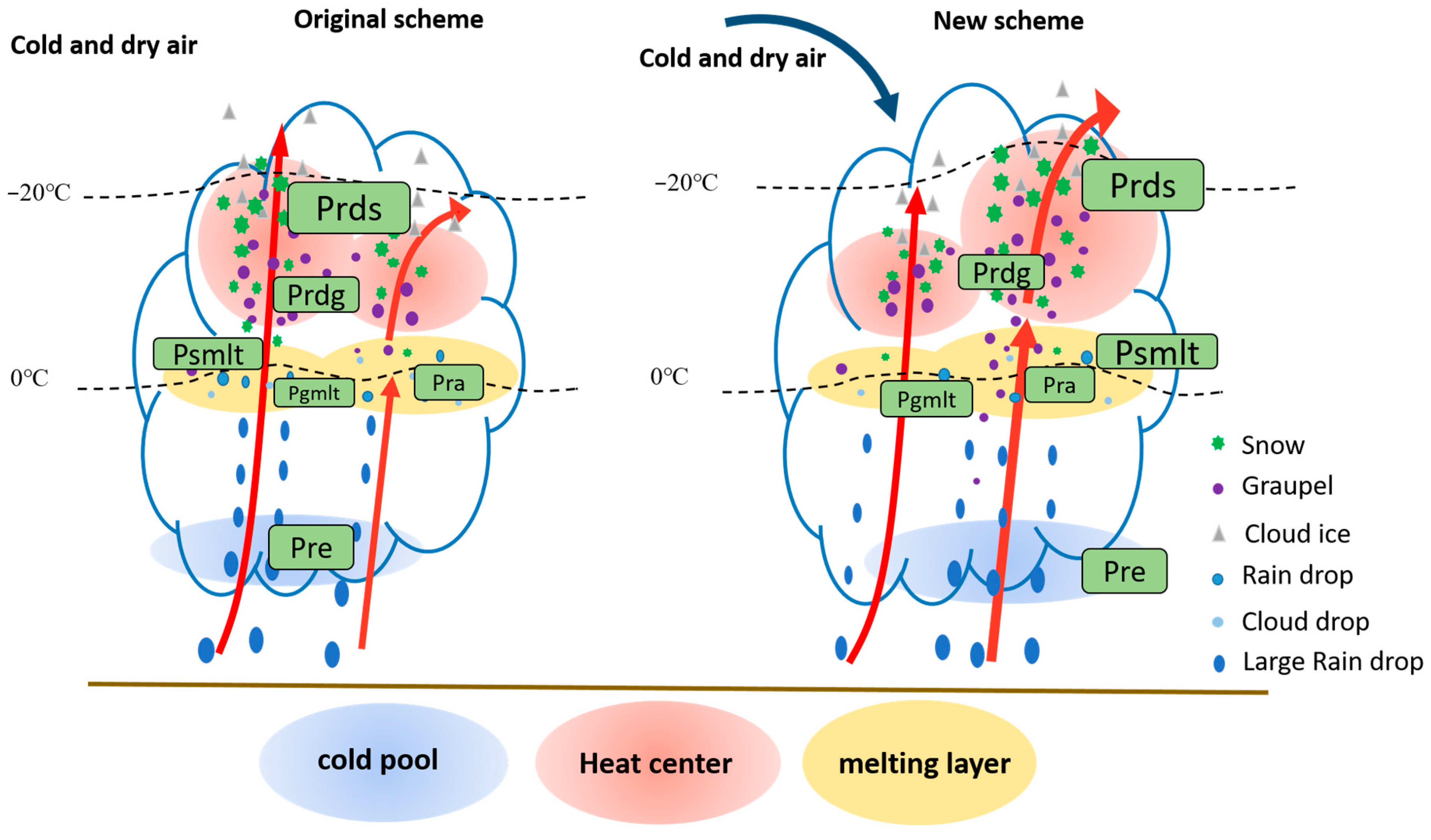
| Experiment | Condensation Function |
|---|---|
| Original | |
| New |
| Experiment | AREA Mean Correlation Coefficient | AREA Mean Root Mean Square Error |
|---|---|---|
| Original_d01 | 0.4847 | 35.385 |
| Original_d02 | 0.506 | 37.154 |
| Original_d03 | 0.559 | 31.159 |
| New_d01 | 0.509 | 33.817 |
| New_d02 | 0.519 | 34.792 |
| New_d03 | 0.594 | 28.657 |
| Experiment | Correlation Coefficient | Root Mean Square Error |
|---|---|---|
| Original_d01 | 0.06 | 36.77 |
| Original_d02 | 0.05 | 36.98 |
| Original_d03 | 0.28 | 34.06 |
| New_d01 | 0.29 | 32.81 |
| New_d02 | 0.30 | 31.69 |
| New_d03 | 0.36 | 31.95 |
Disclaimer/Publisher’s Note: The statements, opinions and data contained in all publications are solely those of the individual author(s) and contributor(s) and not of MDPI and/or the editor(s). MDPI and/or the editor(s) disclaim responsibility for any injury to people or property resulting from any ideas, methods, instructions or products referred to in the content. |
© 2023 by the authors. Licensee MDPI, Basel, Switzerland. This article is an open access article distributed under the terms and conditions of the Creative Commons Attribution (CC BY) license (https://creativecommons.org/licenses/by/4.0/).
Share and Cite
Xu, J.; Xu, L.; Wang, Y.; Ping, F.; Yin, L. Influence of Atmospheric Non-Uniform Saturation on Extreme Hourly Precipitation Cloud Microphysical Processes in a Heavy Rainfall Case in Zhengzhou. Sustainability 2023, 15, 15047. https://doi.org/10.3390/su152015047
Xu J, Xu L, Wang Y, Ping F, Yin L. Influence of Atmospheric Non-Uniform Saturation on Extreme Hourly Precipitation Cloud Microphysical Processes in a Heavy Rainfall Case in Zhengzhou. Sustainability. 2023; 15(20):15047. https://doi.org/10.3390/su152015047
Chicago/Turabian StyleXu, Jin, Liren Xu, Yufei Wang, Fan Ping, and Lei Yin. 2023. "Influence of Atmospheric Non-Uniform Saturation on Extreme Hourly Precipitation Cloud Microphysical Processes in a Heavy Rainfall Case in Zhengzhou" Sustainability 15, no. 20: 15047. https://doi.org/10.3390/su152015047
APA StyleXu, J., Xu, L., Wang, Y., Ping, F., & Yin, L. (2023). Influence of Atmospheric Non-Uniform Saturation on Extreme Hourly Precipitation Cloud Microphysical Processes in a Heavy Rainfall Case in Zhengzhou. Sustainability, 15(20), 15047. https://doi.org/10.3390/su152015047






